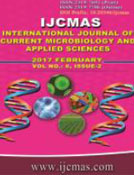


 National Academy of Agricultural Sciences (NAAS)
National Academy of Agricultural Sciences (NAAS)

|
PRINT ISSN : 2319-7692
Online ISSN : 2319-7706 Issues : 12 per year Publisher : Excellent Publishers Email : editorijcmas@gmail.com / submit@ijcmas.com Editor-in-chief: Dr.M.Prakash Index Copernicus ICV 2018: 95.39 NAAS RATING 2020: 5.38 |
Root-knot nematode (RKN), Meloidogyne incognita considered as destructive pathogen to eggplant. Even though the chemical nematicides the effective option, more safety biological control methods are urgently required. Experiments were conducted to study the nematicidal potential of oleander (Nerium oleander) and fish waste (FW) in management of root-knot nematodes Meloidogyne incognita. Three concentrations of oleander dry Leaves(ODL),oleander fresh leaves(OFL) and fish waste(FW) were tested on egg hatching, larvae mortality and nematode management under greenhouse conditions. Results pointed out that all used treatment at the different concentration affected the egg hatching, larvae mortality and nematode management in pots experiment. The highest inhibition of egg hatching was achieved with ODL at 300ppm after 24, 72 and 7 days of treatments starting by 70.59, 76.47 and 79.12 respectively. Also the oleander dry Leaves (ODL) at 300ppm exhibited the highest mortality rates by 63.75, 84.75 and 90.75 % respectively after 24, 48 and 72 h of exposition to the tested treatments. A high reduction in nematode related parameters was observed in eggplant root. Oleander dry Leaves (ODL) at 2%was more effective in reducing the penetration rate of J2s into the eggplant roots after 15 days followed by OFL at 2%. Number of J2s/250 g soil and number of egg-masses; galls; females/root system was decreased markedly by using the different treatments compared with infected un-treated control. The highest significant reduction in all nematode parameters of M. incognita was presented in plants previously treated ODL at 2% while; the least reduction was recorded with FW at 0.5%. Eggplant growth parameters were increased by amended the soil with the different treatments. The highest values of plant high, root length and fresh weight were obtained in plants treated by FW2% followed by OFL 2%. Fresh and dry shoot weight were recorded the highest weight when pots soil treated by FW2% followed by ODL 2% comparing with untreated plants and infected untreated plants. Thus, further study is needed to maximize the efficacy of oleander leaves and fish waste in nematodes management.
 |
 |
 |
 |
 |